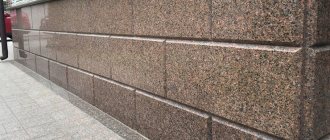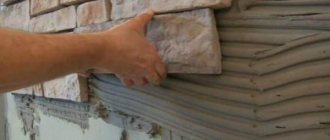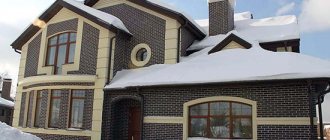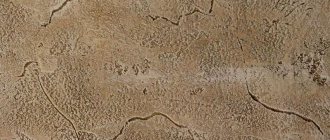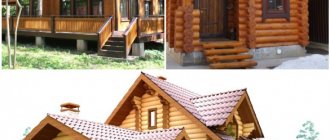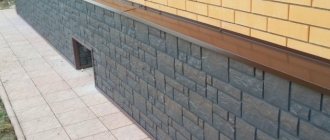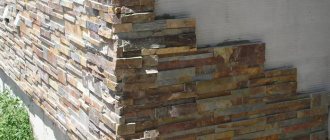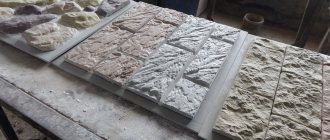Most often, the base is finished using special facade tiles. It has excellent aesthetic qualities, is able to contain the destructive effects of precipitation and temperature changes, and also protects the facade from pollution. In addition, tiles for finishing the base allow you to insulate the walls. The building materials market offers a wide selection of types of tiles for plinth cladding, each of which has its own advantages and disadvantages.
Requirements for tiles for cladding
Based on the expected loads on the base of the house, a number of requirements are imposed on the selected tile:
- Sufficient strength of the material. The structure of the tile must withstand significant mechanical and climatic loads.
- The resistance of the material to temperature changes is assessed, which is very important in regions with harsh climatic conditions.
- Greater thickness of the tile module than the thickness of the tiles for wall decoration.
- Advantageous design, which most models have (for example, clinker tiles for the plinth).
- Be sure to check the reliability of the manufacturing company, which has certified tile manufacturing technology.
Technical characteristics such as the degree of adhesion to the underlying base and the need to prepare the underlying surface for subsequent tiling are also important. The best tiles for the basement of a house fully meet all the requirements.
Possible mistakes
What not to do:
- apply the solution to the tiles pointwise - empty spaces are formed under the material, which can crack upon impact;
- the movement with a notched trowel should be semicircular, and not straight, so the solution adheres better to the base;
- the glue must be moisture resistant, if you chose the wrong one, change it and start the work again;
- the solution should be thick; if there is a lot of water, the material will not last long on the base;
- do not forget about the primer, otherwise the tile will begin to draw moisture from the base wall, which will cause cracks to appear;
- do not start grouting until the joints are dry;
- do not lay tiles without first “trying on” the shape to the wall - this will protect you from unnecessary trimmings.
Optimal selection criteria
The choice of tiles for cladding the basement, especially of a residential building, is best left to professionals. Construction specialists will prepare a project according to which all criteria will be taken into account:
- Soil characteristics and proximity to groundwater.
- The angle of inclination of the land plot. This parameter allows you to roughly estimate the risk of rainwater flowing under the foundation of a building.
- The height of the base and its length.
- Estimated mechanical load on the base of the house.
Specialists will draw up a diagram of the land plot, which will show the location of communication lines, in particular, sewer and water pipes.
Main types of tiles for cladding
Facade tiles, which are used for finishing the basement and not only (swimming pools, basements, underground garages), are produced using special technologies. The techniques used allow manufacturing companies to produce the following types of especially durable tiles on the construction goods market:
- Natural stone tiles.
- Porcelain tiles for the plinth.
- Clinker models with imitation of various surfaces (for example, stone tiles for the basement of a house).
- Material with a polymer structure.
- Tiles created on the basis of natural resins.
Today, ceramic facing tiles for plinths are also popular among craftsmen, however, this model is distinguished by a significantly larger module thickness.
Each of the known types of finishing tiles has a number of features, technical characteristics, and requirements for the underlying surface.
Natural stone tiles
This type of material is the most expensive option, which requires significant financial investments in the tile itself, in preparing the base, and installing a decorative coating.
Popular models include tiles made of marble, granite, slate, and limestone. Such compositions have sufficient strength, perfectly protect the base from moisture, and easily tolerate temperature changes.
Note!
Epoxy grout for tiles: pros and cons, scope, varieties, how to work with it (instructions + photos)
Do-it-yourself tile shower tray step by step: instructions, dimensions, design, installation of communications, types of structures, photos
White tiles in the bathroom: 170 photos of the best ideas and new tile designs. Layout schemes and beautiful combinations
Artificial stone tiles
This coating often acts as an alternative option for cladding the base. Its strength is in no way inferior to the previous type of coating, especially if the production technology uses a combination of natural stone and artificial stone chips.
Thanks to modern technologies, tiles with a smooth or textured surface are being released onto the building materials market, which will allow you to experiment with the design of the base. The admixture of coloring pigments and natural chips gives the surface of the tile modules a unique design and pattern.
Clinker tile types
The most well-known material for finishing the basement of a building today is clinker tiles. It has a very durable structure and resistance to a number of damaging factors.
On the finishing materials market you can find stone-like clinker tiles for decorating the base. The material can be used without replacement for decades, and its resistance to moisture, hail, and chemical compounds is the highest among all known coatings.
Advantages
Foundation tiles have a number of advantages that explain its popularity:
- Durability. In order for the coating to last for several decades, you need to follow the installation rules and use a suitable adhesive.
- Strength. The surface can withstand even strong mechanical stress. Due to the nature of the installation, it is impossible to damage the entire coating at once - it consists of elements that can be replaced.
- Easy to care for. There is no need for additional treatment to protect the surface; dirt can be easily removed with water and a brush.
- Decorative component. There are various modifications that provide individuality and attractive appearance.
The decorative component of plinth tiles is so high that they are used in facade decoration.
The main disadvantage of the material is the difficulty of installation, especially when installed with glue.
Polymer based tiles
Polymer facade tiles for exterior finishing of basements are very popular. The production technology uses the optimal ratio of sand, synthetic polymers, coloring pigments and stabilizers.
Note!
Italian tiles for floors and walls: photos of beautiful tile designs in the bathroom and kitchen. Choosing tile color, style and size
Marble tiles for the bathroom: TOP-200 photos of original design, ideas for mixing and matching
Do-it-yourself tile shower step by step: instructions, algorithm of actions, dimensions, layout diagrams, photo of a shower with and without a tray
It is the presence of the last ingredient that gives the surface of the tiled module special strength and resistance to moisture and other climatic factors.
A distinctive feature of this coating is the possibility of attaching blocks to waterproofing using ordinary screws or self-tapping screws. Facing the facade with polymer tiles allows you to hide all existing irregularities on the surface of the base.
Tiles based on natural resins
A very interesting version of facing tiles can be found in modern construction supply stores. The use of various resins in production allows you to create a unique material that bends at any angle.
If necessary, modular blocks can be cut with construction scissors. After laying, the tiles will provide reliable protection against natural moisture, but only if the finishing work is carried out optimally.
For the glue to completely and successfully harden, it will take about three days and absolutely dry weather.
Note!
Mosaic from broken tiles: step-by-step instructions on how to lay it out with your own hands (140 photo ideas)
Mosaic for the bathroom: TOP-150 photos of new designs, as well as modern ideas for combining mosaic tiles
Do-it-yourself water heated floor under tiles step by step: installation instructions with photos and descriptions, installation and connection
How to care for the facade
Since the artificial analogue of natural granite has almost zero ability to absorb water, it is very easy to care for. This can be done using regular cleaning products. Contaminated areas are washed with detergents. The material is generally non-staining, so it may not need to be cleaned at all. The rain will do all the dirty work.
When purchasing tiles with a structured surface, you need to be prepared for the fact that they retain dirt more easily, since the base is matte. It can be washed with a cloth soaked in water. Semi-polished and polished tiles should be treated with water-repellent compounds to clog the pores.
After this, you can use traditional cleaning products. But they should not have a high acid content, as they can harm artificial granite. Seams, which are the gateway to moisture and low temperatures, can be especially affected. The use of products with abrasive particles should be avoided, as careless cleaning of the surface of the material can lead to scratches.
Preliminary surface finishing
One of the key points of construction and finishing work is the preparation of the underlying surface. Laying the plinth with tiles begins immediately after the preparatory work:
- The old coating from the base must be removed. Pay attention to even the smallest pieces that can cause poor adhesion of the new material.
- The surface of the base must be leveled, especially if there are unevenness and gross defects.
- After thorough cleaning of dust, they begin laying hydro- and thermal insulation. If necessary, install a reinforcing mesh.
Applying several layers of primer to the surface will increase the resistance of the facing tiles to low temperatures.
Foundation lining methods
You can veneer the base in different ways. Each option is selected based on a specific situation:
- Frame mounting. Finishing work begins with the installation of sheathing. For this, a metal profile or wooden beam is used. This method is suitable when special types of tiles with fastening strips are used for work or the features of the parts do not allow direct installation. The frame method has the disadvantage of open joints, so they must be sealed.
Cladding on a metal frame is difficult to arrange and quite expensive - Fixation with glue. The tiles are laid on a special solution. The technology requires serious surface preparation and compliance with numerous rules.
- Fastening with screws. This option almost completely repeats the first method. The difference is that there is no sheathing, so the base should not have any defects.
Foundation tiles are an excellent solution that combines an excellent decorative appearance and structural protection.
Do-it-yourself tiling of the base with tiles
In practice, two main methods of tiling the base are used: dry and wet (classic finishing) methods. Step-by-step finishing of the basement of a house with tiles using the dry method:
- Attach a lathing made from a profile to the prepared surface.
- They begin to attach the facing tiles on top of the sheathing using self-tapping screws.
The technique is quite simple, but has its drawbacks. It is impossible to achieve complete tightness in this way, which means that moisture will get between adjacent tile modules.
The second method of finishing the plinth with facade tiles is recognized as classic, and is more often used in practice:
- After installing the reinforcing mesh (this stage of work is optional), an adhesive solution is applied to the surface of the base. Reinforcing mesh is often used when finishing the base with clinker tiles.
- Tile laying begins from the upper far corner, constantly monitoring the quality of the arrangement of tile modules using a building level.
- Be sure to maintain the time required for the adhesive to dry.
After the solution has completely hardened, they begin to grout the joints with a moisture-resistant compound. For ease of use, spatulas of various sizes are used. This approach makes it possible to make the tile masonry completely sealed and resistant to moisture.
Grouting joints
Processing of seams is carried out after the adhesive mixture has completely dried - up to three days. It is better to choose frost-resistant compounds for installation and filling joints from one manufacturer. The grout composition is applied with a rubber spatula into the joint cavities. For a day, the treated surface must be protected from moisture and precipitation. After drying, the remaining grout is removed with a damp cloth, sponge, or soft brush.
The differences between plinth tiles are practicality, reliability, and aesthetics.
An example of a finished plinth protection made of artificial stone:
Average score of ratings is more than 0
Share link
Comments There are no comments yet, but you could be the first...
